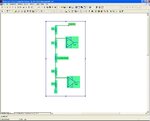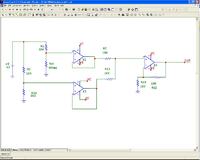torakaru
Member level 2
How to clip (defined range) the output signal of an In-Amp?
Hello Folks,
I have designed a circuit (basically an Instrumentation amplifier with G=1, with 3 single OpAmps), to measure the differences in resistance, when I place a resistance in their inputs that can go from zero (shortcircuit) up to infinitum (open-circuit) ohms:

So, depending of the value of the "R_for_Test", the output of the OpAmp U1 will go from 0V up to +10V approximately.
Well, my question comes now. If I would like that the output range of U1 will go ONLY from "+0.5V up to +9.5V", how would be possible to be done easily?
I though about the following solution (I added a resistor divider at test_pad_1):

But the problem is that the output goes from "0V up to +9.5V", but not from "+0.5V up to +9.5V".
Do you have any idea to help me, please?
Anyway, thanks a lot in advance!
Hello Folks,
I have designed a circuit (basically an Instrumentation amplifier with G=1, with 3 single OpAmps), to measure the differences in resistance, when I place a resistance in their inputs that can go from zero (shortcircuit) up to infinitum (open-circuit) ohms:

So, depending of the value of the "R_for_Test", the output of the OpAmp U1 will go from 0V up to +10V approximately.
Well, my question comes now. If I would like that the output range of U1 will go ONLY from "+0.5V up to +9.5V", how would be possible to be done easily?
I though about the following solution (I added a resistor divider at test_pad_1):

But the problem is that the output goes from "0V up to +9.5V", but not from "+0.5V up to +9.5V".
Do you have any idea to help me, please?
Anyway, thanks a lot in advance!
Last edited:






